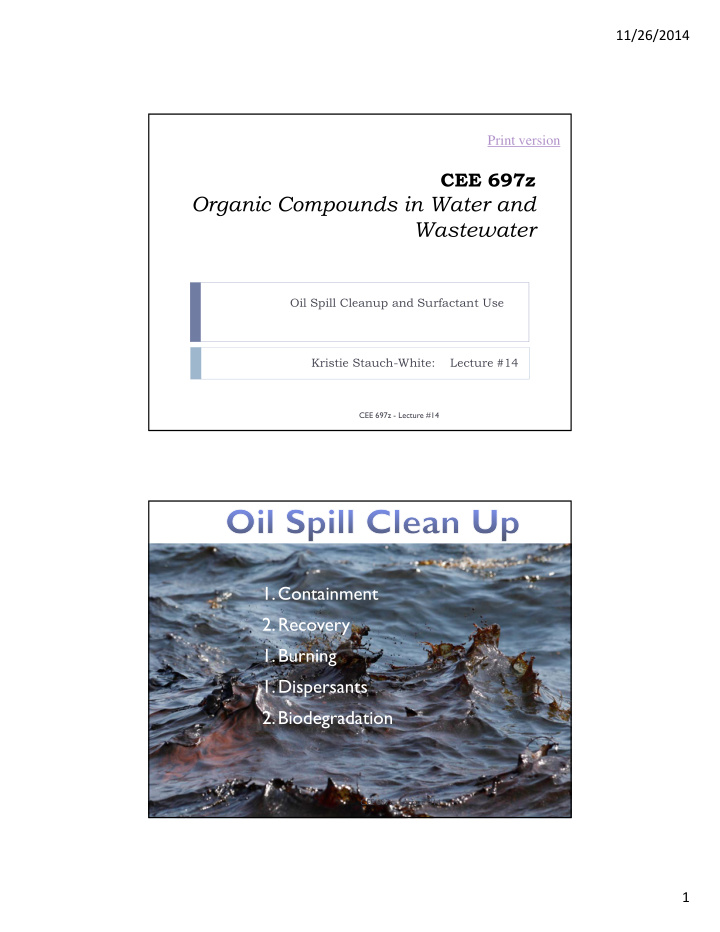



11/26/2014 Print version CEE 697z Organic Compounds in Water and Wastewater Oil Spill Cleanup and Surfactant Use Kristie Stauch-White: Lecture #14 CEE 697z - Lecture #14 1.Containment 2.Recovery 1.Burning 1.Dispersants 2.Biodegradation CEE 697z - Lecture #14 1
11/26/2014 Booms and skimmers • Containment Dome • CEE 697z - Lecture #14 http://www.federallabs.org/flc/sandlg/state_profile/?state_id=127 CEE 697z - Lecture #14 2
11/26/2014 Skimmers and Sorbent materials: polyester Fiber Mats • Super-Hydrophobic Absorbents • – polyethylene mop-like pads Hair Mats • Hay • Pine Shavings • CEE 697z - Lecture #14 Burning CEE 697z - Lecture #14 Department of Defense 3
11/26/2014 CEE 697z - Lecture #14 Helen K. White, 2014, Dept. of Chemistry, Haverford College 1.Containment 2.Recovery 1.Burning 1.Dispersants 2.Biodegradation CEE 697z - Lecture #14 4
11/26/2014 Solvents – decrease viscosity Surfactants – surround and emulsify oil Encourages oil to sink and come into contact with bacteria in the water column Also encourages oil droplets to spread into fur and feathers of marine animals CEE 697z - Lecture #14 Surfactants amphipathic CEE 697z - Lecture #14 5
11/26/2014 Tiny oil droplets suspended in the water column are CEE 697z - Lecture #14 more available for biodegradation Direct Interfacial Uptake of Oil/Surfactant Emulsion Droplets Oil Degrading Bacteria: Symbiotic Bacteria: Alcanivorax borkumensis Azotobacter – provides fixed nitrogen • • CEE 697z - Lecture #14 Pseudomonas Cyanobacteria – provides fixed nitrogen and oxygen • • 6
11/26/2014 1.8 million gallons of Corexit 9500 applied at Deep Water Horizon Oil Spill in 2010 Active Ingredients: dioctyl sodium sulfosuccinate (DOSS) -Reported to be quickly biodegradable (>90% in 12-19 days) -Found in Coral Beds 6 months after application -Found on Coastline 4 years later -T oxic to Marine Life -T oxicity increased when mixed with Oil CEE 697z - Lecture #14 Helen K. White, Haverford College & Woods Hole Oceanographic Institute Clearly, more research is needed to find less toxic and more biodegradable surfactants for Oil Spill Remediation • Commercial Lecithin & Cellulose Polymer based surfactant – mixture of natural phospholipids in oil CEE 697z - Lecture #14 Lisa Kemp, University of Mississippi 7
11/26/2014 CEE 697z - Lecture #14 • Soaps Sodium Stearate • Detergents • Household Cleaners • Foaming Agents (sodium lauryl sulfate in toothpaste and shampoo) CEE 697z - Lecture #14 8
11/26/2014 Soap – 1 st Widely used Surfactant ABS – Alkylbenzene sulfonates used in laundry products* - left calcium and magnesium salt precipitates - foaming in sewage water, treated sewage and river water - led to ban in Germany and voluntary bans in the U.S. LAS – Linear alkylbenzene sulfonates - introduced in 1960s - improved biodegradability - less foaming - levels of surfactants in aquatic CEE 697z - Lecture #14 environments Anionic Cationic Non-ionic General Structure of LAS (linear alkylbenzene sulfonate) CEE 697z - Lecture #14 Knepper & Eichhorn, 2006 9
11/26/2014 Dioctyl Sodium Sulfosuccinate Anionic Surfactant CEE 697z - Lecture #14 Primary Biodegradation – minor alterations in chemical structure of surfactant molecule – may result in loss of surface-active properties, lowering toxicity CEE 697z - Lecture #14 Knepper & Eichhorn, 2006 10
11/26/2014 Anionic Surfactants are methylene blue-active substances (MBAS) Non-ionic surfactants are bismuth iodide-active substances (BiAS) Additional testing required to determine the fate of surfactant molecules after primary degradation CEE 697z - Lecture #14 Biodegradation of Surfactants Organization of Economic Co-Operation and Development (OECD) • developed International Standard Methodologies for testing the biodegradability of surfactants • Ready Biodegradability – real environmental conditions (60% CO2 formation or 70% DOC removal within 28 days) *likely to be degraded • Inherent Biodegradability – ideal conditions *potential to be degraded • Simulation Biodegradability –WWTP conditions CEE 697z - Lecture #14 11
11/26/2014 What happens to Surfactants from household and industrial use? CEE 697z - Lecture #14 The majority reach Wastewater Treatment Plants where they are effectively eliminated. Some persistent compounds and their metabolites are found in raw water that is treated for drinking water. CEE 697z - Lecture #14 12
11/26/2014 Additional Research is needed to better understand the fate of these compounds and their metabolites. Thank you CEE 697z - Lecture #14 To next lecture CEE 697z - Lecture #14 13
Recommend
More recommend